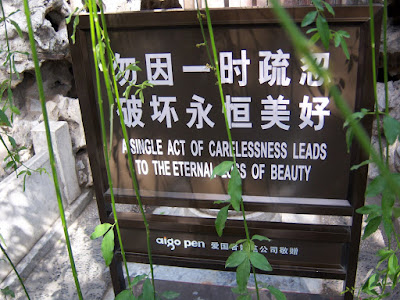 This week, I (Ryan) went to Beijing with a big group of students for the annual Beijing Model United Nations conference. It was a good trip. There were some unfortunate incidents along the way (four boys got into a little trouble, but nothing too serious), but for the most part, everyone had a great time and spirits were high. On Monday, the group (below, minus the aforementioned four) went to the Forbidden City.
This week, I (Ryan) went to Beijing with a big group of students for the annual Beijing Model United Nations conference. It was a good trip. There were some unfortunate incidents along the way (four boys got into a little trouble, but nothing too serious), but for the most part, everyone had a great time and spirits were high. On Monday, the group (below, minus the aforementioned four) went to the Forbidden City.

 It is really hard to describe the size of this place. It was built in 1406 and served as the imperial palace until the communist take-over.
It is really hard to describe the size of this place. It was built in 1406 and served as the imperial palace until the communist take-over.


 At the back of the palace is a large garden filled with very old trees that have been cut and mended into strange and interesting shapes. There are also a lot of sculptures and formations in this area which are nothing more than lake stones that have been excavated and hauled from far away to be displayed in their original state. We were lucky that the day we visited the palace was warm and sunny. For most of the trip, it was overcast, and the air hung thickly between buildings like grey curtains. It was nice to be among trees and flowers.
At the back of the palace is a large garden filled with very old trees that have been cut and mended into strange and interesting shapes. There are also a lot of sculptures and formations in this area which are nothing more than lake stones that have been excavated and hauled from far away to be displayed in their original state. We were lucky that the day we visited the palace was warm and sunny. For most of the trip, it was overcast, and the air hung thickly between buildings like grey curtains. It was nice to be among trees and flowers.



 Of course, it was pretty crowded, and the dominant fashion seemed to include matching baseball caps:
Of course, it was pretty crowded, and the dominant fashion seemed to include matching baseball caps:
 In this ancient city, it is easy to get lost in the history of the place. However, there are frequent reminders of the realities of a more present history.
In this ancient city, it is easy to get lost in the history of the place. However, there are frequent reminders of the realities of a more present history.
 Mao Zedong's image hangs over the entrance to the old imperial palace, and his body is embalmed and on display in a mausoleum just outside in Tienanmen Square:
Mao Zedong's image hangs over the entrance to the old imperial palace, and his body is embalmed and on display in a mausoleum just outside in Tienanmen Square: The trip also provided a really good opportunity to hang out with students. There were eighteen on this trip, along with three teachers, including myself. One of my students never really felt comfortable breathing Chinese air, and rarely put down his book:
The trip also provided a really good opportunity to hang out with students. There were eighteen on this trip, along with three teachers, including myself. One of my students never really felt comfortable breathing Chinese air, and rarely put down his book:



 We also did a lot of shopping at the silk market and pearl market. For the most part, prices in these markets are about 90% higher than they actually should be, and you have to do a lot of haggling.
We also did a lot of shopping at the silk market and pearl market. For the most part, prices in these markets are about 90% higher than they actually should be, and you have to do a lot of haggling. As is expected when dealing with teenagers (and myself) there was a lot of eating going on. I know I had duck on three different occasions, but for the most part I didn't ask what I was putting in my mouth.
As is expected when dealing with teenagers (and myself) there was a lot of eating going on. I know I had duck on three different occasions, but for the most part I didn't ask what I was putting in my mouth. 



 A lot of tea was consumed as well, which helped wash down all the oil. Notice the glossy shine on the dish below.
A lot of tea was consumed as well, which helped wash down all the oil. Notice the glossy shine on the dish below.







